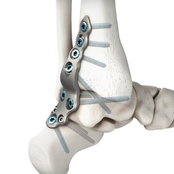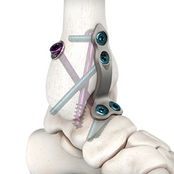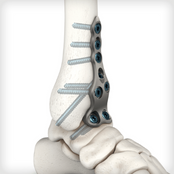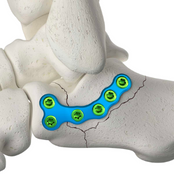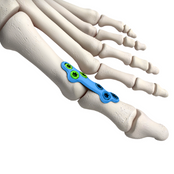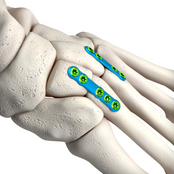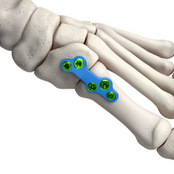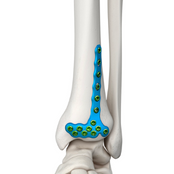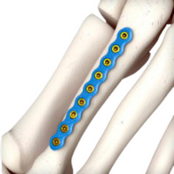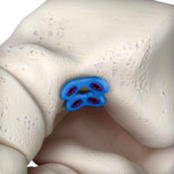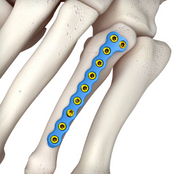Lower Extremeties
MRS Ortho proudly distributes the full line of In2Bones, Extremity Medical, and Medline surgical products.




Each surgical system listed below links to the Extremity Medical website, where you can find more information on that specific system.
 Jones Union System
Jones Union System
DESIGNED FOR 5th METATARSAL ANATOMY
Screws designed to optimize purchase and compression specifically for Jones unions
- Distal threads have a cortical thread pitch
- Proximal threads have a cancellous thread pitch
Innovative instruments
- Intramedullary reamers provide a local autogenous graft to assist in healing
- Instruments assist in placing the shortest screw to avoid fracture displacement
Omni AF Ankle Fracture System

• Anatomically contoured for optimal patient fit
• Unique distal screw hole clusters designed to offer multiple screw placement options.
• Low profile and chamfered lead-in edges minimize soft tissue irritation.
Establish maximum compression across the joint and robust fixation rigidity for challenging patient anatomies with one implant and one incision.
- PEEK improves stability as it mimics the stiffness of cortical bone
- Designed to provide stable IP Joint Fixation
- Cannulated Design allows for the option to pin the MPJ temporarily
 Axis Beam® Charcot Fixation System
Axis Beam® Charcot Fixation System
The Axis Fixation System provides a Superconstruct™ designed to:
- Bridge Beyond the Area of Injury
- Optimize Implant Strength
- Maximize Mechanical Function
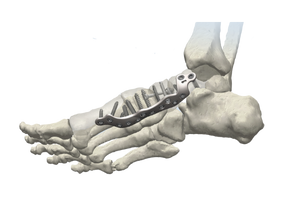 Axis Plate® Charcot Fixation System
Axis Plate® Charcot Fixation System
- Amplifies compression regardless of the patient’s bone quality
- Adds multiplanar fixation and stability for enhanced construct durability
- Reduces risk of implant pullout
 CompressX2 Compression Screw
CompressX2 Compression Screw
With precision instrumentation, the CompressX2 headless compression screw system offers a variety of diameters and lengths to cover all the bases for mid and rear-foot procedures.
Omni Plating System

PlantarFiX Post uses advanced technology to provide greater compression across the joint and increase stability, which reduces the risk of plantar gapping and improves fusion outcomes, regardless of patient bone quality.
Omni MTP
Consistent Plantar-side Compression
• Post acts as a metal cortex
• Lag Screw interdigitates with Post plantar (where it is needed most)
– Lag compression not dependent on bone quality
– Better lag screw purchase = better compression Increased Stability
• Lag Screw/Post interface enhances pull-out strength
Unique X-Post technology distributes compressive force across greater surface area, delivering uniform compression and higher peak compression. The X-Post creates a reinforced bone bridge that provides higher peak compression and added stability in compromised bone.
IO Fix Trio
T he low-profile Trio plate provides uniform compression and rotational stability—without any lateral wall hardware, to minimize peroneal tendon irritation.
he low-profile Trio plate provides uniform compression and rotational stability—without any lateral wall hardware, to minimize peroneal tendon irritation.
 Express Staple System
Express Staple System
High-quality titanium construction inserter with fast and consistent loading of the low-profile staple. Available in two reusable instrument kits, eliminating the waste of plastic inserters. Sized for all foot and ankle applications.
Contact your local Extremity Medical sales representative
To learn more about Extremity Medical, visit their website.
For Extremity Medical press releases & articles visit their website
To contact Extremity Medical, visit their website


Each surgical system listed below links to the ConMed website, where you can find more information on that specific system.
 CoLink®NX Plate
CoLink®NX Plate
Up to 1.5mm of compression is possible using the Compression Slot, an elliptical slot with progressive depth.
 CoLink®XP Plating System
CoLink®XP Plating System
MTP, Lapidus, H-Plates, Y-Plates as well as several Universal Plates
 Reference Toe System®
Reference Toe System®
1ST MTP Implant
– No angled cuts
– Broachless implantation
– Angled metatarsal stem matches natural declination angle
 RTS®Lesser MTP
RTS®Lesser MTP
Implant System
– For Treatment of Degenerative, Painful, and/or Alignment Deformities of the Lesser MTP Joints
– Designed to Eliminate Pain and Restore Joint Function
 DuaFit™ PIP
DuaFit™ PIP
Proximal Interphalangeal Implant
4 lengths
2 angles: 10° and 0°
OS2-VP™ Compression Staples
Low Profile Design
For Akin type osteotomies with compression on release
26° Angles option to match the metaphysis of the phalanx
 STERILE DELIVERY
STERILE DELIVERY
I.B.S.®S Sterile Screws
With Instruments
SNAP-OFF SCREWS
Individually Packaged
2.2 and 2.7mm
NeoSpan® SE Compression Staples
Sterile, Disposable Kit with Instrumentation
Easy To Use Staple Inserter
Designed to deliver constant active compression
Multiple sizes from 8 to 25mm
CoLag® Compression Screws
Differential Pitch Compression
Unique Thread / Head Design Creates Compressive StabilitySM
Available in 2.5, 3.0, 4.0, 5.0 & 6.7mm Dia.
 PitStop®
PitStop®
Subtalar Implant
Anatomical Shape with Lock-in Flanges
X-ray Markers for Placement Confirmation
Invisible on x-ray
 5MS®Bunionette Plate
5MS®Bunionette Plate
Low-profile plate designed to provide strong fixation of 5th metatarsal diaphyseal osteotomies.
 5MS® Jones Fracture Screws
5MS® Jones Fracture Screws
The dual lead primary threads and differential pitch secondary threads provide increased rotational stability of bone fragments, while the uniquely designed low profile head provides improved holding power.
 5MS® Lateral Neck Plate
5MS® Lateral Neck Plate
Anatomically curved and scalloped to fit the midshaft metatarsal and distal metatarsal tuberosity.
 5MS® Plantar Plates
5MS® Plantar Plates
Designed for improved resistance to torsion and plantar gapping for highly active patients including athletes.
 5MS® Pseudo Jones Hook Plate
5MS® Pseudo Jones Hook Plate
Plate hooks are placed intra-osseous, proximal to the fracture to provide a means of reducing the avulsed fragment.
 ENGINEERED STERILE ALLOGRAFT
ENGINEERED STERILE ALLOGRAFT
AlloAid®NAIL
New Fixation for Chevron/Austin Osteotomies
Engineered with multiple wedge facets
Designed to anchor the Nail in the bone and secure bone segments together
 AlloAid®PIP
AlloAid®PIP
ENGINEERED STERILE ALLOGRAFT FOR ARTHRODESIS
Straight and 10° Angled Configurations
Designed with Positioning Ramps at the joint line to help accurately position the implant and assure a press fit, and reduce the chance of subsidence.
 TriWayTMAnkle Fusion Nail
TriWayTMAnkle Fusion Nail
TibioTaloCalcaneal Arthrodesis System
– Solid nail for increased strength with cannulated reaming system for ease of insertion
– Anatomical 7° Posterior Offset Nail
– Multi-planar fixation for optimal stability
– Radiolucent targeting guide with aiming guide for subtalar compression screw
STERILE DELIVERY I.B.S.®C Sterile Screws
I.B.S.®C Sterile Screws
With Instruments
Individually Packaged
2.0, 2.5, 3.0, 3.5, 4.5, 6.5 and 8.0mm
 ClearGuard LE®
ClearGuard LE®
ENDOSCOPIC SOFT TISSUE RELEASE SYSTEM
360° Panoramic Visualization
Proprietary Guided Track System
Contact your local ConMed sales representative
To learn more about ConMed, visit their website.
For ConMed press releases & articles, visit their website
To contact ConMed, visit their website


Each surgical system listed below links to the Medline website, where you can find more information on that specific system.
Universal
Polyaxial Locking: Ø2.7/3.5/4.0mm
Left and Right
Polyaxial Locking: Ø2.7/3.5/4.0mm
Universal
Polyaxial Locking: Ø2.7/3.5/4.0mm
Standard and Large (Universal)
Polyaxial Locking: Ø2.7/3.5/4.0mm
0mm, 6mm, 8mm, and 10mm Wedge
Polyaxial Locking: Ø2.7/3.5/4.0mm
Universal
Polyaxial Locking: Ø2.7/3.5/4.0mm
5mm, 7.5mm, and 10mm Step
Polyaxial Locking: Ø2.7/3.5/4.0mm
Standard and Long (Left and Right)
Talus Extension Standard and Long (Left and Right)
Polyaxial Locking: Ø2.7/3.5/4.0mm
Omni AF Ankle Fracture System

• Anatomically contoured for optimal patient fit
• Unique distal screw hole clusters designed to offer multiple screw placement options.
• Low profile and chamfered lead-in edges minimize soft tissue irritation.
2-Hole
4-Hole
4-, 5-, 6-, 7-, 8-, 9-, 10-, 11-, 12-Hole (Universal)
Polyaxial Locking: Ø2.7/3.5/4.0mm
Small and Standard (Left and Right)
Polyaxial Locking: Ø2.7/3.5/4.0mm
SYNDEX™ with Constrictor® Technology
One Size
Extra Small, Small, Medium, and Large (Left and Right)
Polyaxial Locking: Ø2.7/3.5/4.0mm
Small and Standard (Left and Right)
Polyaxial Locking: Ø2.7/3.5/4.0mm
3-, 4-, 5-, 6-, 7-, 8-, 9-, 10-, 11-, 12-Hole (Universal)
Polyaxial Locking: Ø2.7/3.5/4.0mm
Extra Small, Small, Medium, and Large (Left and Right)
Polyaxial Locking: Ø2.7/3.5/4.0mm
Universal (Left and Right)
Polyaxial Locking: ø3.5/4.0/4.5/5.5mm
Small and Standard (Universal)
Polyaxial Locking: ø4.5/5.5mm
Universal (Left and Right)
Polyaxial Locking: ø3.5/4.0/4.5/5.5mm
Small and Standard (Left and Right)
Polyaxial Locking: ø3.5/4.0/4.5/5.5mm
Small and Standard (Universal)
Polyaxial Locking: ø4.5/5.5mm
Universal (Left and Right)
Polyaxial Locking: ø4.5/5.5mm
Small and Standard (Left and Right)
Polyaxial Locking: ø4.5/5.5mm
Universal (Left and Right)
Polyaxial Locking: ø4.5/5.5mm
Standard and Offset
Small, Medium, Large (Left and Right)
Polyaxial Locking: Ø3.5mm *Ø2.7/4.0mm locking and non-locking screws available in the Core and Ancillary Foot Recon trays.
Small, Medium, Large (Left and Right)
Polyaxial Locking: Ø3.5mm *Ø2.7/4.0mm locking and non-locking screws available in the Core and Ancillary Foot Recon trays
Small and Standard (Left and Right)
Polyaxial Locking: Ø2.7/3.5/4.0mm
Small, Medium, Large (Left and Right)
Polyaxial Locking: Ø3.5mm *Ø2.7/4.0mm locking and non-locking screws available in the Core and Ancillary Foot Recon trays
Extra Small, Small, Medium, Revision, and Long Revision (Left and Right))
0°, 5°, and 10° Dorsiflexion Options
Polyaxial Locking: Ø2.7/3.5/4.0mm
Standard and Long (Universal)
Polyaxial Locking: Ø2.7/3.5/4.0mm
1st TMT ICJ Bridging Arm (Left and Right)
2nd TMT ICJ Bridging Arm (Left and Right)
Straight 3-, 4-, 5-Hole (Universal)
Offset 4- and 5-Hole (Universal)
Polyaxial Locking: Ø2.7/3.5/4.0mm
Left and Right
Polyaxial Locking: Ø2.7/3.5/4.0mm
Midfoot Fusion Straight Plates
3-, 4-, 5-, 6-, 7-, 8-Hole (Universal)
Polyaxial Locking: Ø2.7/3.5/4.0mm
Standard and Large (Universal)
Polyaxial Locking: Ø2.7/3.5/4.0mm
Standard, Revision Graft-Spanning, 1, 2, 3, and 4mm Step (Universal)
1st TMT ICJ Bridging Arm (Left and Right)
Polyaxial Locking: Ø2.7/3.5/4.0mm
Straight 3-, 4-, 5-Hole (Universal)
Offset 4- and 5-Hole (Universal)
Polyaxial Locking: Ø2.7/3.5/4.0mm
Ø3.7/4.0mm: 65 – 150mm
Anterolateral Distal Tibia Plates
4-Hole (88mm)
6-Hole (112mm)
8-Hole (120mm)
10-Hole (144mm)
12-Hole (168mm)
14-Hole (196mm)
16-Hole* (216mm)
18-Hole* (240mm)
Left and Right
Polyaxial Locking: Ø2.7/3.5/4.0mm
3-Hole (62mm)
6-Hole (98mm)
9-Hole (134mm)
Universal
Polyaxial Locking: Ø2.7/3.5/4.0mm
Posterolateral Distal Tibia Plates
3-Hole (58mm)
5-Hole (82mm)
7-Hole (106mm)
9-Hole (130mm)
Left and Right
Polyaxial Locking: Ø2.7/3.5/4.0mm
4-Hole (72mm)
6-Hole (96mm)
8-Hole (136mm)
10-Hole (160mm)
12-Hole (184mm)
14-Hole (208mm)
16-Hole* (232mm)
18-Hole* (256mm)
Left and Right
Polyaxial Locking: Ø2.7/3.5/4.0mm
4-, 5-, 7-, 9-Hole
Polyaxial Locking: Ø2.0/2.4/2.7mm
Small, Medium, Large
Polyaxial Locking: Ø2.0/2.4/2.7mm
Universal
Polyaxial Locking: Ø2.0/2.4/2.7mm
4-, 5-, 7-, 9-Hole
Polyaxial Locking: Ø2.0/2.4/2.7mm
Universal
Polyaxial Locking: Ø2.0/2.4/2.7mm
4-, 5-, 7-, 9-Hole
Polyaxial Locking: Ø2.0/2.4/2.7mm
Standard and Large (Left and Right)
Polyaxial Locking: Ø2.0/2.4/2.7mm
Left and Right
Polyaxial Locking: Ø2.0/2.4/2.7mm
Contact your local Medline sales representative
To learn more about Medline, visit their website.


Each surgical system listed below links to the Vilex website, where you can find more information on that specific system.
ALPHALOK™ METFX
METFX LOCKING PLATING SYSTEM
- Standard Plates: 2.0mm & 2.5mm Non-Locking and Locking Screws
- Mini Plates: 1.5mm Non-Locking and Locking Screws
The ALPHALOKTM METFX Plating System provides a comprehensive range of anatomically contoured standard and mini fracture and fusion plates specifically designed for the fore and midfoot.
ALPHALOKTM
RECON LOCKING PLATING SYSTEM
- Innovative screw sizing options of 2.7mm and 3.5mm, which are universally accepted in all plate holes
- Low profile 1.3 mm plating designed to reduce soft tissue irritation
ALPHALOKTM features low-profile 1.3mm, Titanium Alloy Ti6AI4V plates that accept 2.7mm and 3.5mm polyaxial locking screws that can be angled ±15° for a total range of 30°.
HINTERMANN SERIES H2®
2-COMPONENT, SEMI-CONSTRAINED IMPLANT
- Size-matched UHMWPE inlay assembly in 4 different thicknesses and anterior/neutral/posterior offsets
- Intended to offer anatomic loading (non-stress shielding) at all bone-implant interfaces
The Hintermann Series H2® is indicated as a total ankle replacement (TAR) in primary or revision surgery of ankle joints damaged by: Systemic arthritis of theankle (e.g., rheumatoid arthritis, hemochromatosis), Primary arthritis (e.g., de-generative disease), Secondary arthritis (e.g., post-traumatic, avascular necrosis, provided enough of the talus is preserved to support the implant).
HINTERMANN SERIES H3®
3-COMPONENT, NON-CONSTRAINED IMPLANT
- Low profile instrumentation, designed by surgeons, for ease of use and consistent reproducibility
- Tibial and talar components are coated with titanium plasma and hydroxyapatite(HaP) for uncemented use
The Hintermann Series H3® PMA approved and indicated as a non-cemented total ankle replacement (TAR) in primary or take-down surgery of painful arthritic ankle joints due to: Primary osteoarthritis, Post-traumatic osteoarthritis and Arthritis secondary to inflammatory disease (e.g., rheumatoid arthritis, hemochromatosis, etc.
TITANEX™ I
HEADED CANNULATED SCREW SYSTEM
- Titanium implants are designed with low-profile heads to minimize soft-tissue irritation while offering maximum compression.
- 3.0mm and 4.0mm accept 1.4mm guide wires offering greater stiffness and reducing bent wires in surgery.
The TITANEX™ I Cannulated Screw System contains headed 2.0mm, 3.0mm, and 4.0mm color-coded titanium implants and instrumentation. Each Vilex screw is hand sharpened, delivering the renowned bite and engagement Vilex customers have come to expect.
TITANEX™ II
HEADED CANNULATED SCREW SYSTEM
- The pitch ratio and dual-threaded core provide optimized compression for fixation
- Self-drilling and self-tapping fixation devices featuring individually hand-sharpened cutting tips
The TITANEXTM II Cannulated Screw System contains headless 2.0mm, 2.5mm, 3.0mm, and 4.0mm color-coded titanium implants and instrumentation. Each Vilex screw is hand sharpened, delivering the renowned bite and engagement Vilex customers have come to expect.
DYNEX
EXTERNAL RING FIXATION SYSTEM
- Specialty components such as hinges, z-plates, and linear distractors for complex cases and extreme deformity correction
- Specialty components such as hinges, z-plates, and linear distractors for complex cases and extreme deformity correction
The DYNEX External Fixation System is designed to address the stabilization of fractures and osteotomies, rear and midfoot arthrodesis, adult and pediatric leg lengthening, and correction of bone deformity in the upper and lower extremities.
REDEMPTION™
MIDFOOT NAILS & BEAMS
-
REDEMPTIONTM features both 7.5mm and 8.2mm Midfoot Nails to address a variety of patient anatomies.
- Comprehensive sizing of: 5.0mm, 6.5mm, and 8.0mm partially and fully threaded beams to address advanced reconstruction needs
REDEMPTION™ Midfoot Nail and Beams System may be used for definitive treatment singularly, or used in conjunction with ancillary fixation such as external fixation, additional beams, plates, or contact casting until bony fusion has occurred.
FIBUNAIL™
FIBULAR NAILING SYSTEM
- FibuNail™ implants are manufactured from Ti6Al4V titanium alloy for enhanced strength and biocompatibility
- Accepts two (2) 3.5mm Syndesmotic Screws and four (4) 2.7mm multiplanar cross screws: (2) AP and (1) LM
The FibuNail™ Intramedullary Nail System was designed as an alternative to traditional ORIF methods for treating ankle fractures. The FibuNail™ system is designed to minimize incision size and soft tissue dissection on the lateral malleolus.
HAMMERFUZE™
HAMMERTOE COMPRESSION SYSTEM
- Completely cannulated system for both straight and 10° angled implants
- CompTWIST™ helical barb design offers additional compression at arthrodesis
HammerFUZE™ is designed to address the fixation of osteotomies and reconstruction of the lesser toes and lesser fingers following correction procedures for hammertoe, claw toe, mallet toe, and other deformities of the feet and hands.
MEND/EPF SYSTEMS
ENDOSCOPY SYSTEMS
- EPF two-portal system compatible with 4.0mm, 30-degree scope
- MEND one-portal system compatible with 2.7mm, 30-degree scope
MEND is a minimally invasive, single port, endoscopic surgical technique for intermetatarsal nerve decompression after dividing the transverse intermetatarsal ligament.
NITINEX
NITINOL COMPRESSION STAPLES
- No freezing or heat preparation required
- Complete range of implant sizes for hand and foot procedures ranging 8mm-25mm
NITINEX Memory Compression Staples offers a simple and fast alternative to locking plates or screw fixation1. NITINEX staples are made of shape memory nickel-titanium alloy and nitinol and were designed to offer a broad range of implant sizes to match patient anatomy while maintaining a low profile with a flat implant bridge.
TALEX™
SUBTALATR STABILIZATION SYSTEM
-
Grippex™ thread technology is designed to improve bite and reduce rotational backout
-
5MM – 10MM size options to accommodate anatomical differences and address various clinical scenarios and surgical needs
The Talex™ Subtalar Stabilization System is the latest advancement in the evolution of subtalar implants. Talex™ is a minimally invasive treatment option indicated for use on patients with flat feet or a pronated subtalar joint and is intended to be used for a finite period of. Talex™ can be removed after the conditions causing the pronation have been corrected.
Contact your local Vilex sales representative
To learn more about Vilex, visit their website.






























